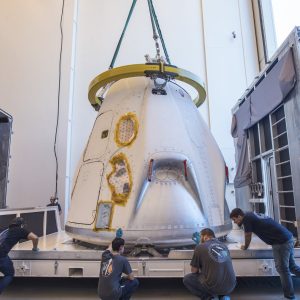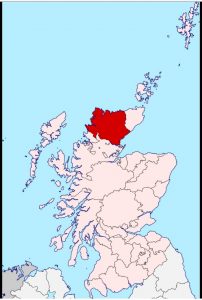The big news this week is the arrival at Cape Kennedy of the first “spaceworthy” crewed version of Space X’s Dragon Capsule, see image below. This arrival is in preparation an unmanned test launch to be conducted later this year.

Know as Demonstration Module 1 (DM-1), the capsule had just finished two weeks of environmental tested at NASA’s Plum Brooke Station in Ohio. Here the DM-1 was placed in the facilities huge vacuum chamber and exposed to all of the hazards of a trip in Earth Orbit. In addition to a vacuum the chamber can also subject whatever equipment is being tested to either the intense, unfiltered sunlight or the absolute darkness of space, the extremes of heat and cold.
These tests were all conducted to verify that the DM-1 capsule is ready to take human beings into space as a part of NASA’s Commercial Crew Program which will take astronauts to the International Space Station (ISS). The fact that these tests were successfully completed in only two weeks is a good sign that the DM-1 is ready for its test mission later this year. The image below shows an unmanned Dragon supply capsule taking off on its way to the ISS, a preview of the forth coming DM-1 mission.

While this first test mission will be unmanned it will still conduct a full mission profile, rendezvousing with the ISS and ending with a re-entry and splashdown, just as a manned mission would. The mission is currently slated to begin on August 31st 2018 but NASA has indicated several times that the launch date will probably be pushed back until sometime in the fourth quarter of the year with the first actual manned launch sometime in the first half of 2019.
Meanwhile Space X’s competitor Boeing is also making considerable progress in preparing their proposed manned capsule the Starliner, see image below. The Starliner’s initial, unmanned test flight is also still scheduled for August but it is also likely to be pushed back into the fourth quarter of the year.

Part of the reason for the slippage is the already heavy schedule of launches at Cape Kennedy along with the already scheduled crew transfer and resupply missions to the ISS. Hopefully NASA will work out the scheduling conflicts while both Space X and Boeing finish preparing their capsules. NASA’s is soon going to run out of purchased tickets on the Russian Soyuz spacecraft so by next year the US will have no other way of getting into space.
There was also a second story this week which has a certain, it’s about time quality to it. The United Kingdom has just decided on the location of their spaceflight launch facility. Sixty years into the space age and Britain, one of the world’s most advanced nations, a leader in space technology has only now decided from where to launch its satellites.
There are a couple of very good reasons as to why the UK waited so long before getting into the satellite launch business. Britain is a small, densely populated country with little room from which to safely launch big rockets. Also most launch facilities, like Cape Kennedy and the European Space Agency’s launch site in Guyana, are close to the equator where the spin of the Earth can actually give a 1500 KPH start to any launch.
In recent years however, miniaturized satellites launched into polar orbits have become a sizeable slice of the space industry market and the UK wants to grab a piece of that pie. The chosen location of Sutherland on the A’Mhoine peninsula on Scotland’s north coast will allow rockets to be fired due north. This would place the satellite into an orbit that will allow the Earth to rotate beneath it so that eventually the entire planet can be observed by the satellite’s sensors. See the map below.

The UK Space Agency will build the launch facility with the help of the American firm Lockheed-Martin and hopes that the first launches will take place sometime in the early 2020s.
